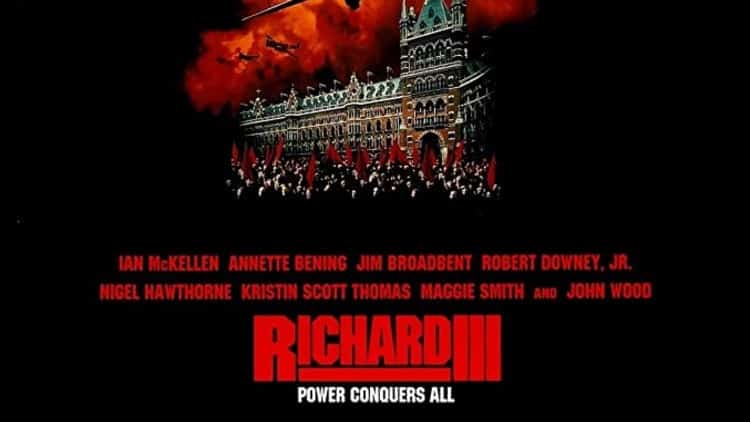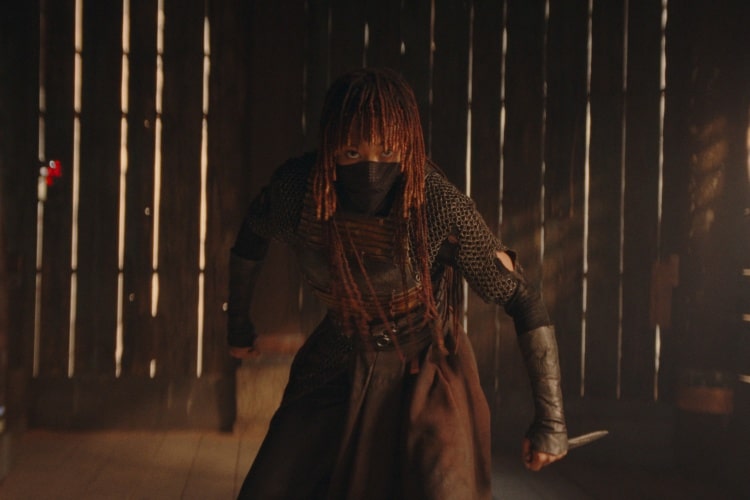A (moving) picture is worth 1000 words
Main Cast: Ian McKellan, Annette Bening, Maggie Smith, Kristin Scott Thomas, Robert Downey, Jr.
Director: Richard Loncraine
It’s all about images. Indeed, I left my first viewing of Ian McKellan’s Richard III wondering if it could be done just as brilliantly if it had been a silent film – this despite my love for the language of Shakespeare. For it was the images that made this film float and it was the images that stayed with me long after I’d first seen the movie.
I’ll admit that despite being an English major for two years before switching to the slightly more lucrative field of journalism, I had never read Richard III nor seen it performed. In some ways, I was avoiding it. I’m rather a fan of Richard III. I do not believe him to be the villain that Shakespeare made him out to be. Historically, he became the scapegoat for the War of the Roses which let the country move on to a more peaceful time. When Ian McKellan’s 1995 version of Richard III came to the local art movie house, my husband (the real Shakespeare lover in our family) convinced me to go with him.
Richard III is a wonderful villain. Indeed, Shakespeare had irrevocably cast him as the consummate medieval villain, so what better way to “update” him than to place him in the shoes of the man often considered the greatest villain of the 20th Century. No, Director Richard Loncraine doesn’t call him Adolph Hitler, he and Ian McKellan just paint him that way. There are tautly flapping flags with Richard’s boar that remind us of Nazi flags in Hitler Germany. McKellan takes poses on stands that hearken back to Nuremberg and royal gaiety is contrasted with black and white films of combat viewed in smoky rooms.
Although I had not read the play before seeing the movie, I was familiar with the history of the period – a factor that helped me keep up with this fast-paced 104-minute long movie. Its opening scene is done without words and sets up story in a way that reminded me of a James Bond movie opening sequence. The language has not been changed from the original, but necessity did demand several cuts.
About a month ago, after my husband had spent a summer performing in a stage production of Richard III as King Edward and Oxford, we rented this movie to watch it once again. It was still as captivating as the first time around.
So what was it that was captivating?
Loncraine and McKellan (who starred as Richard III and helped write the screenplay) leave you with no doubts that you are in a Nazi-style England. They set up an elaborate what-if scenario that is frighteningly realistic. After the opening prequel where we see Richard destroying the rightful rulers, we are immediately taken to a pomp-and-circumstance style ball of the 30s. The famous opening speech:
Now is the winter of our discontent
Made glorious summer by this sun of York
Is made by Richard at an old-fashioned microphone and broadcast to everyone celebrating at the ball. Halfway through the speech, Richard turns to us as he and the camera leave the ballroom and enter a lavatory. He takes us into his confidence as he urinates, showing us contempt even as he begins his seduction of the audience by revealing his plans and telling us that he is determined to prove a villain.
He then woos Anne Warwick in a sterile morgue with the naked corpse of her husband acting as the backdrop to some of Shakespeare’s finest insults. There are few scenes in all of literature that can compare to this wooing scene when it comes to outrageous and reprehensible love scenes. I was impressed with Kristin Scott Thomas‘ acting in this scene. It is not easy to pull off a scene where you make the audience believe that you have been won over by your beloved husband and father-in-law’s murderer while you stand above your husband’s still bloodied corpse. Yet, she takes Richard’s ring and soon becomes his devoted, if later disillusioned, wife.
Although I did not notice the absence the first time I saw the movie, the subsequent viewings after seeing a stage version and actually reading the play, left me disappointed that Queen Margaret was edited out of the film. She quickly became one of my favorite roles in the play – second only to Richard himself – and I was sorry to see her left out of the screenplay. But then, she is a somewhat sympathetic character and in the movie, we feel sympathy only for the villain. If there is anyone that competes for our attention as also worthy of sympathy, it is Maggie Smith’s brilliant portrayal of Richard’s mother, the Duchess of York.
While Robert Downey, Jr. struck me as being just a bit too smarmy for Rivers (a character I’ll confess to not being overly fond of anyway), it certainly made it easier to be gleeful with Richard when Richard’s plotting against Rivers is successful.
Indeed, the success of this movie is that it does make you feel gleeful with Richard. He’s a foul, “poisonous, bunchbacked toad,” but we like him. He is charismatic, he is beguiling, he shares with us his schemes, and we delight as he succeeds. So at the end, when the final credits are rolled, we find we have to again ask ourselves the question, “How was it possible for so many people to be fooled by Hitler?” and realize that the answer may be more complicated than we previously gave it credit for being.





Leave a Reply